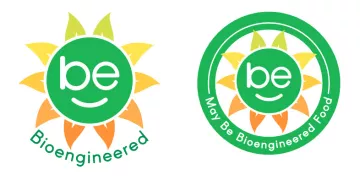The Great GMO Switcheroo
Will the USDA’s plan to rebrand the polarizing term backfire?
Ever since foods containing genetically modified ingredients arrived on U.S. grocery store shelves some 20 years ago, the public’s reception to those foods has been all over the map—er, supermarket aisle. Some people have expressed concern about the perceived health risks of consuming GMOs. (While there is scant evidence to support such concerns, your typical Whole Foods shopper isn’t exactly seeking to add GMOs to their diet). Others have sought to avoid GMO foods out of concern for the environmental impacts of these pesticide- and herbicide-resistant crops. Meanwhile, some self-described eco-modernists have expressed excitement about GMOs’ potential to boost crop yields to feed an explosive world population.

Mainly, though, “GMO” has become a loaded term, sowing confusion and skepticism wherever it appears. The seemingly endless tug-of-war over GMOs has caused many people to wonder, “How would consumers react to a label that says, ‘Produced With Genetic Engineering?’”
Thanks to a 2016 law signed by President Obama, we’ll soon get to find out—in theory, that is. While the USDA’s new 106-page proposed regulation mandates that food packaging and grocers disclose those ingredients that are derived from GMO soybeans, corn, and other crops, it effectively does away with the now-common household terms “GMO” and “genetically modified.”
Rather, food labels will employ a term most consumers probably aren’t familiar with: “bioengineered.” And some packages won’t have any actual labels, just QR codes that consumers can scan for more information—an unwieldy option at best and one that will be totally out of reach for those who don’t have smartphones. If it’s not obvious that this labeling framework—which is open for public comment through today, July 3—has been designed to skirt the controversy surrounding GMOs, then take a look at the USDA’s proposed labels, at right. They feature a brightly shining, healthy-looking sun.
Enter a group of University of Vermont researchers who just came out with a study that makes the USDA’s cryptic, sunshiney style of disclosure seem a little silly. Opponents of GMO labeling such as the Grocery Manufacturers Association—which represents many manufacturers of food and beverage products—have long fought against GMO labels, arguing that they would function as packaging kryptonite and scare shoppers away. But the UVM study, which launched in July 2016, when Vermont became the first state to pass a law requiring GMO disclosure labels, shows that such transparency actually made Vermonters 19 percent less suspicious when it comes to genetically modified organisms. That’s right—rather than functioning as a skull-and-crossbones insignia, the labels caused the nation’s arguably crunchiest state to develop a decreased aversion to GMOs.
“Labels can instill a sense of increased trust and increased autonomy,” says Jane Kolodinsky, an applied consumer economist and the author of the study. She and coauthor Jayson Lusk have been regularly measuring Vermonters’ shopping preferences via polls that include the question “Overall, do you strongly support, somewhat support, have no opinion, somewhat oppose, or strongly oppose the use of GMOs in the food supply?” Two years after Vermont’s law went into effect, labeled packages of cereal, candy, salad dressing, and other processed foods on grocery store shelves are selling as well as ever—and Kolodinsky is just as surprised as you might be. “The Vermont labels were not smiley faces, just simple disclosure, placed somewhere on the package, stating ‘Produced or partially produced using genetic engineering,’” she says. “Our simple analysis shows that the simplest, most transparent way to label might in fact be the easiest way.”
The nationwide GMO-labeling law is still in the process of being implemented, so there’s no way to tell whether the smiley “BE” sun will become an industry laughingstock, the next Joe Camel that's notorious among consumer advocates, or even whether such a blatant GMO rebranding campaign will see the light of day. But as any cookie-pilfering child or naughty dog could tell the USDA, you arouse more suspicion when you act like you’ve got something to hide.
“If labels aren’t clear, easy to understand, and simple, consumers could face information overload pretty quickly,” Kolodinsky cautions. “And if you don’t have the right information to make your own choice, then someone else is making that choice for you, and Americans, who vote with their dollars, don’t tend to respond well to that.”
 The Magazine of The Sierra Club
The Magazine of The Sierra Club




